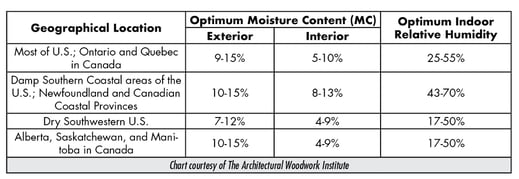Hoteliers and designers often place FF&E (furniture, fixtures, and equipment) orders well in advance, especially for renovations or redesigns. It’s a smart move — everything’s ready when you need it, and production delays won’t slow you down.
But what about the time between order completion and when you’re ready to receive it?
That’s where FF&E storage comes in.
Proper storage helps protect your furniture and fixtures, keeping them in top condition until you’re ready for installation.
Important Storage Considerations for FF&E
When you invest in beautiful casegoods for your hotel, you want to make sure they arrive in good condition -- even after a stint in storage. Whether your hotel casegoods manufacturer is storing your order or you’ve found another storage option, you should consider:
- Protection
- Climate control
- Humidity control
1. Protection
Wouldn’t it be perfect if each hotel casegood you ordered was stored in its own space by itself, never to be disturbed until shipping?
Particularly with large orders, FF&E is often stored with other casegoods -- remember the government warehouse at the end of “Raiders of the Lost Ark?”
Because of its close proximity to other pieces, there’s a higher chance for damage from accidental dings, dents, and scratches. If your hotel casegoods manufacturer is storing your order, ask how it plans to keep it protected.
2. Climate Control
Temperature fluctuations and direct exposure to the elements or sunlight can cause major damage to FF&E, such as:
- Warping
- Swelling
- Shrinkage
- Fading
Storing hotel casegoods in a controlled environment with consistent temperatures ensures your products arrive on-site in the same condition as when they got off the manufacturing line.
3. Humidity Control
This goes hand-in-hand with climate control.
Humidity is one of the most damaging things to hospitality FF&E.
In humid climates, air moisture can cause casegood materials such as wood to swell, which leads to cracking and splitting. In addition, moisture that collects on casegood surfaces can leave oxidation stains.
In low-humidity climates, some materials may lose moisture and shrink, also causing cracking and splitting.
According to The Architectural Woodwork Institute, here are the optimum humidity ranges in North America:

Your FF&E Storage Checklist
Storing your hotel casegoods properly helps your pieces look great upon installation.
Here are some general storage guidelines:
- Store your pieces flat on a level surface
- Ensure your pieces are at least 4” off of the floor
- Cover the pieces to ensure they remain clean and moisture-free
For interior storage, make sure the space is:
- Dry and well ventilated
- Protected from sunlight and heat
- Humidity-controlled and protected from moisture
- Between 60-90℉
For exterior storage, make sure the space is:
- Clean and free of debris that could scratch or damage your pieces
- Protected from direct sunlight
- Protected from moisture
Post-Installation: FF&E Care
In a sense, once your hotel’s FF&E is installed, you’re storing it.
Casegood maintenance once its installed is similar to how its cared for when in storage.
Remember to:
- Maintain the same environmental conditions as during storage.
- Ensure the building’s interior temperature is neither raised nor lowered substantially, as this can cause swelling or shrinking.
- Avoid high-heat situations, such as exposure to hot-light heat sources, hot pans, or hot plates near or in direct contact with your pieces.
Frequently Asked Questions About Hotel FF&E StorageHere are some frequently asked questions we get about hotel FF&E storage. How Long Can Ff&E Be Stored Without Risking Damage?The duration that FF&E can be stored without risking damage largely depends on the type of materials used and the conditions of the storage environment. Generally, if properly stored in climate-controlled conditions, furniture, fixtures, and equipment can be safely kept for several months to a few years. However, it is advisable to regularly check the items for any signs of deterioration or damage, especially for prolonged storage periods. What Certifications Or Standards Should A Storage Facility Have To Meet The Necessary Climate And Humidity Control Requirements For Ff&E?A storage facility for FF&E should ideally have certifications such as ISO 9001, indicating quality management systems, along with industry-specific standards that demonstrate compliance with climate and humidity control practices. Additionally, facilities should provide documentation of temperature and humidity monitoring systems that maintain optimal conditions for preserving various materials used in FF&E. What Steps Should Be Taken If Damage Occurs During Storage?If damage occurs during storage, the first step is to assess the extent of the damage to determine whether the item can be repaired or needs to be replaced. Documentation of the damage through photographs and notes is important for insurance claims. If the storage facility is responsible, the next step is to communicate with them regarding the issue, as they may have policies or insurance to cover repairs or replacements. Finally, it’s important to evaluate the storage conditions to prevent future occurrences. |
Effective Care and Storage of Hospitality Casegoods
Your hotel’s FF&E represents an investment.
Just like any other major purchase, it should be protected as much as possible — even when it’s waiting to be used.
When working with a hotel furniture manufacturer in the U.S.A. that’s willing to store your FF&E until you’re ready for it, make sure it’s taking the proper precautions in keeping your order. You can rest easy knowing that your hotel casegoods are being stored in a safe, well-regulated environment.
Work with a Manufacturer Who Understands Storage
Our Proper Care & Storage of Hospitality Casegoods eBook helps you choose materials that balance aesthetics and longevity while providing guidance on maintenance.
This article was originally written in August of 2020 and was recently updated to reflect industry trends.

